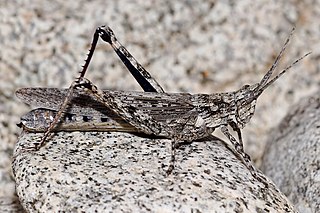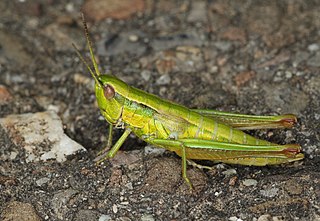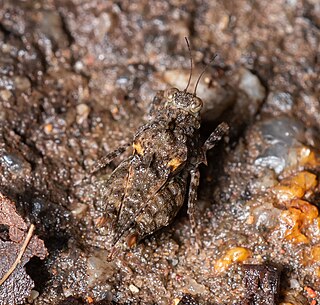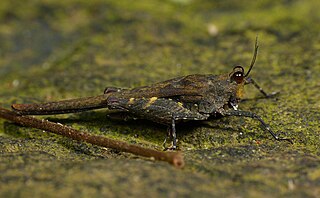
Acrididae are the predominant family of grasshoppers, comprising some 10,000 of the 11,000 species of the entire suborder Caelifera. The Acrididae are best known because all locusts are of the Acrididae. The subfamily Oedipodinae is sometimes classified as a distinct family Oedipodidae in the superfamily Acridoidea. Acrididae grasshoppers are characterized by relatively short and stout antennae, and tympana on the side of the first abdominal segment.

The grasshopper subfamily Acridinae, sometimes called silent slant-faced grasshoppers, belong of the large family Acrididae in the Orthoptera: Caelifera.

Tetrigidae is an ancient family in the order Orthoptera, which also includes similar families such as crickets, grasshoppers, and their allies. Species within the Tetrigidae are variously called groundhoppers, pygmy grasshoppers, pygmy devils or "grouse locusts".

Gomphocerinae, sometimes called "slant-faced grasshoppers", are a subfamily of grasshoppers found on every continent but Antarctica and Australia.

Discotettix is a genus of groundhoppers found in Malesia, Brunei, Indonesia and the Philippines; they may be known as "spiky pygmy devils". After revision, it is the type genus of the tribe Discotettigini and now placed in the subfamily Scelimeninae.

Scelimena is a genus of ground hoppers in the family Tetrigidae, with records from India, Indo-China, Malesia and Papua New Guinea.

Batrachideinae is a subfamily of groundhoppers or pygmy grasshoppers. There are thought to be 20 genera in Batrachideinae, with genera found in the Americas, Africa, Asia and Australia.

Tetriginae is a large subfamily of groundhoppers or pygmy grasshoppers. Members of Tetriginae occur on every continent except Antarctica.

Cladonotinae is a subfamily of groundhoppers containing more than 70 genera and 260 described species. These insects are found in tropical areas world-wide.

Metrodorinae is a subfamily of groundhoppers or pygmy grasshoppers. There are at least 90 genera and more than 590 described species, found in South America, Africa and Asia.
Coptotettix is an Asian genus of ground-hoppers in the subfamily Tetriginae.

Eucriotettix is a genus of ground-hoppers in the tribe Thoradontini. Species have been recorded from tropical Asia: India, Indochina, through to New Guinea.

Thoradonta is an Asian genus of ground-hoppers and typical of the tribe Thoradontini.

Gryllini is a tribe of crickets and typical of the family Gryllidae. Species are terrestrial, carnivorous or omnivorous and can be found in all continenents except Antarctica.
Bolivaritettix is an Asian genus of ground-hoppers in the subfamily Metrodorinae and not assigned to any tribe.
Epitettix' is a genus of ground-hoppers in the subfamily Cladonotinae and typical of the new (2023) tribe Epitettigini; records are from Madagascar and Asia.

Criotettix is an Asian genus of ground-hoppers in the tribe Criotettigini.
Loxilobus is a genus of ground-hoppers in the tribe Thoradontini. Species have been recorded from West Africa, throughout Asia and Australia.
Mazarredia is an Asian genus of ground-hoppers in the subfamily Metrodorinae and not assigned to any tribe.

Falconius is a genus of Asian groundhoppers in the tribe Scelimenini, erected by Ignacio Bolívar in 1898. Species have been recorded from India, Indochina and Malesia.
















